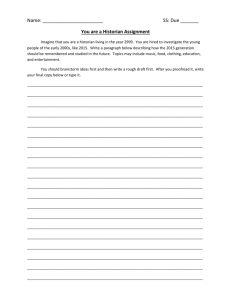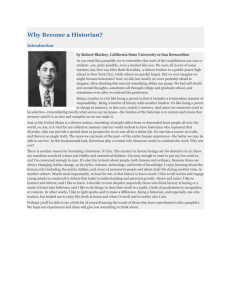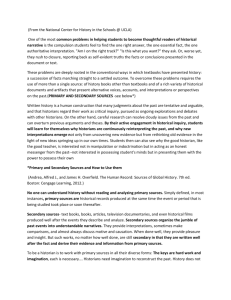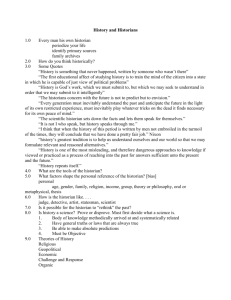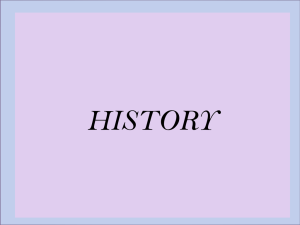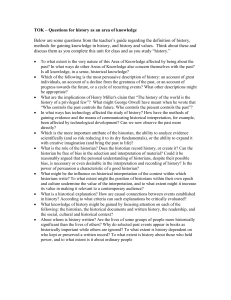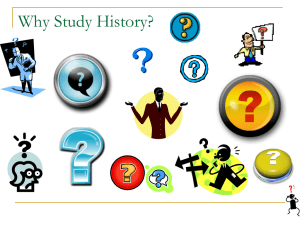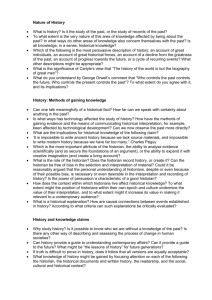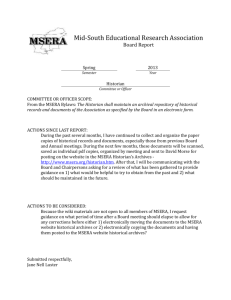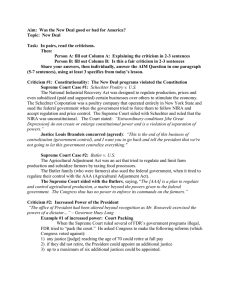Reading primary sources
advertisement
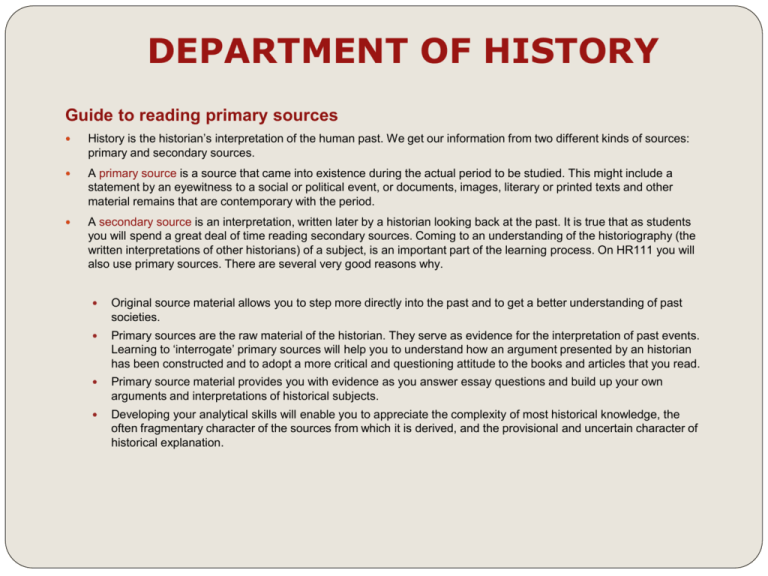
DEPARTMENT OF HISTORY Guide to reading primary sources History is the historian’s interpretation of the human past. We get our information from two different kinds of sources: primary and secondary sources. A primary source is a source that came into existence during the actual period to be studied. This might include a statement by an eyewitness to a social or political event, or documents, images, literary or printed texts and other material remains that are contemporary with the period. A secondary source is an interpretation, written later by a historian looking back at the past. It is true that as students you will spend a great deal of time reading secondary sources. Coming to an understanding of the historiography (the written interpretations of other historians) of a subject, is an important part of the learning process. On HR111 you will also use primary sources. There are several very good reasons why. Original source material allows you to step more directly into the past and to get a better understanding of past societies. Primary sources are the raw material of the historian. They serve as evidence for the interpretation of past events. Learning to ‘interrogate’ primary sources will help you to understand how an argument presented by an historian has been constructed and to adopt a more critical and questioning attitude to the books and articles that you read. Primary source material provides you with evidence as you answer essay questions and build up your own arguments and interpretations of historical subjects. Developing your analytical skills will enable you to appreciate the complexity of most historical knowledge, the often fragmentary character of the sources from which it is derived, and the provisional and uncertain character of historical explanation. DEPARTMENT OF HISTORY Reading a Primary Source Reading an original document or describing an image may seem a daunting task at first, especially when it originated in the early modern period, when attitudes, values and modes of expression were often very different from our own. The most important principle to grasp at the start is that primary sources cannot be taken at face value. They do not speak for themselves. They have to be interrogated critically. A series of basic questions have to be asked of any primary source before we can begin to decide what it can tell us about the historical subject we are addressing. What date is it? If an historical text is describing or commenting upon a particular event then it is important to check how close the date of the document is to the date of the events described. What type of source is it? Is it an image or a text? If it is a text then what sort of document is it: personal (e.g. a letter or a diary), legal (e.g. a witness statement), governmental (e.g. records of parliaments or other representative institutions, diplomatic dispatches)? Who wrote/produced it? If you know or can establish this, then use reference works to find out more about the author. If you cannot find out who wrote it, then you may be able to reach some sort of conclusion about who might have written it. For example, a legal document will probably have been written by a legal official. You can then consider what assumptions, values, attitudes, prejudices, and vested interests the author/producer might be likely to have had. Why was it written/produced? For example, texts such as printed sermons or conduct book have a prescriptive purpose. They are works of moral instruction, designed to tell people how they should live their lives. From the sixteenth century many conduct books were written about the purpose of marriage and the proper ordering of relations between husband and wife. These documents offer immensely valuable information about conventional attitudes and values, but they cannot tell us whether or how these ideas influenced day-to-day social behaviour. Documents such as diaries or letters, on the other hand, are personal, individual records of daily lives and give us an insight into how ideas shaped actual marital practice. DEPARTMENT OF HISTORY For whom is the text/ image intended, to whom is it addressed? For instance, statements made by witnesses, plaintiffs and defendants in legal cases were directed to the judge. His presence was bound to be a distorting factor, for people presented themselves as they wished to be seen, in some cases trying to influence the authorities in their favour. Thus we find that these documents rarely contain criticism of official institutions or powerful authority figures. What is the main point that the author is trying to make? The original sources that have been chosen for you to look at on this course, whether texts or images, will have at least one specific point that you should focus on and summarise. Is there any unintentional (unwitting) evidence to be gleaned from this source? For example, early modern legal records, in particular records of the church courts, contain long and full witness statements. Witnesses were asked to say what they knew about the alleged offence, and they did so through lengthy, explanatory descriptions of what they saw and heard. Historians who read these depositions are often not interested in the case, but they are interested in the incidental details the source ‘against the grain’. Are there any details, such as factual references to people or events that need to be commented upon? It is always important, if possible, to identify people or events alluded to, even if indirectly. Ask yourself where the information came from and do your best to check it out. Are there any archaic/foreign/technical words or phrases that you do not understand and/or that need to be translated? Dictionaries are very helpful research tools. Use them to make sure you understand all the words in the document and if possible find out how contemporaries understood them. How does this source relate to other evidence from the period? Does this text/ image confirm or contradict what we ‘know’ from other primary and secondary sources about the subject? How typical or exceptional are the arguments, assumptions attitudes and values? DEPARTMENT OF HISTORY The purpose of applying all these critical questions to a primary source is a first step to asking what the source can tell you about the past. Interrogating source material enables you to test its usefulness as a source of historical information and to justify to yourself and to others why it can be used as evidence to support an interpretation/argument about a historical subject. Learning to develop your own interpretations will take time and a great deal of practice. It will also require you to use your imagination. This is why the historian E. P. Thompson once said, ‘the historian has got to be listening all the time … If he listens, then the material itself will begin to speak through him’. To help you to develop your skills of source-criticism, the course requires you to complete an assessed task in which you will be expected to comment on a piece of original source material. You will also be expected to answer a primarysource based question in your examination in the Summer Term. The grade criteria below will help you to see that these questions have different aims from essays. Grade criteria for primary source criticism questions A first class piece of source criticism will identify the source and its authorship with precision, date accurately and demonstrate an excellent awareness of historiographical issues and the broader historical context. An upper second class piece of source criticism will satisfactorily identify and date the source, and focus on some of the key historical issues raised by it. A lower second class piece of source criticism will make accurate observations about details in the source, but will fail to relate it to its broader historical context. A third class piece of source criticism will describe or paraphrase the contents of the text/image. It might basically but accurately contextualise the source but provide only irrelevant, inaccurate or unfocussed comment on related historical issues. A failed piece of source criticism will simply paraphrase the text or describe the image without any attempt at explanation or will wrongly identify the historical context and/or issues to which the source relates. Further reading on source-criticism Marwick, A., The Nature of History, London, 2002, Chap. 5. Marius, R., A Short Guide to Writing About History, New York, 2002, Chaps. 2,4.
